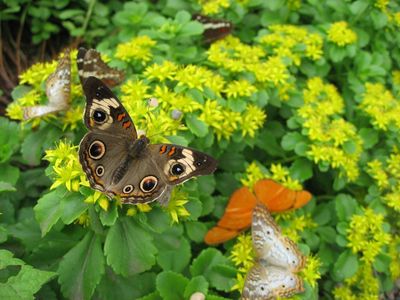About Butterfly Gardening in Zone 5
Before you begin picking out plants for the butterflies, give some thought to their needs. Butterflies are cold blooded and need the sun to warm their bodies. To fly well, butterflies need body temperatures of between 85 to 100 degrees F. (29-38 C.). So, select a site for the zone 5 butterfly garden plants that is in the sun near a sheltering wall, fence, or stand of evergreens that will protect the insects from winds. You might also incorporate some dark colored rocks or boulders into the zone 5 butterfly garden. These will heat up in the sun and give the butterflies a place to rest. When the insects can stay warm, they fly more, eat more, and search for mates more often. Hence, they lay more eggs and you get more butterflies. Commit to not using pesticides. Butterflies are extremely susceptible to pesticides. Also, Bacillus thuringiensis kills both moth and butterfly larvae, so even though this is a biological pesticide, it should be avoided.
Hardy Plants that Attract Butterflies
Butterflies go through four life cycles: egg, larvae, pupae, and adult. Adults feed on the nectar of many types of flowers and larva feed mostly on the leaves of a more limited variety. You may want to plant both plants that attract the adult insects and those that will sustain the larvae or caterpillars. Many butterfly plants also attract hummingbirds, bees, and moths. Consider blending native and non-native plants in the butterfly garden. This will broaden the number and type of butterflies that visit. Also, plant large groupings of flowers together, which will attract more butterflies than just a plant here and there. Choose plants that bloom on a rotating basis throughout the season, so the butterflies have a continuous source of nectar. There are some plants (like butterfly bush, coneflower, black-eyed Susan, lantana, verbena) that are virtual butterfly magnets, but there are many others that are equally attractive to one species or more. Mix annuals in with perennials. Perennials for butterflies include:
Allium Chives Forget-me-not Bee balm Catmint Coreopsis Lavender Liatris Lily Mint Phlox Red valerian Sunflower Veronica Yarrow Goldenrod Joe-Pye weed Obedient plant Sedum Sneezewood Pentas
Annuals that can be tucked in amongst the above perennials include:
Ageratum Cosmos Heliotrope Marigold Mexican sunflower Nicotiana Petunia Scabiosa Statice Zinnia
These are only partial lists. There are many more butterfly attractive plants like azalea, blue mist, buttonbush, hyssop, milkweed, sweet William… the list goes on.
Additional Plants for Butterflies
While you’re planning your butterfly garden, be sure to incorporate plants for their offspring. Black Swallowtail caterpillars seem to have a rather human palate and prefer to dine on carrots, parsley, and dill. Wild cherry, birch, poplar, ash, apple trees, and tulip trees are all favored by Tiger Swallowtail larvae. Monarch offspring prefer milkweed and butterfly weed and the larvae of the Great Spangled Fritillary prefer violets. Buckeye butterfly larvae grub on snapdragons while Mourning Cloak nibbles on willow and elm trees. Viceroy larvae have a yen for fruit from plum and cherry trees as well as pussy willows. Red-spotted purple butterflies also prefer trees such as willows and poplars, and Hackberry butterfly larvae feed on hackberry, of course.
